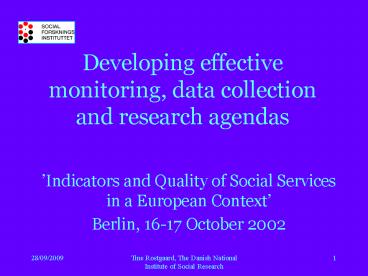Developing effective monitoring, data collection and research agendas - PowerPoint PPT Presentation
1 / 16
Title:
Developing effective monitoring, data collection and research agendas
Description:
General lack of cross-national consensus of what constitutes the policy field of ... National schemes vary greatly in terms of length of leave schemes, tax credits ... – PowerPoint PPT presentation
Number of Views:49
Avg rating:3.0/5.0
Title: Developing effective monitoring, data collection and research agendas
1
Developing effective monitoring, data collection
and research agendas
- Indicators and Quality of Social Services in a
European Context - Berlin, 16-17 October 2002
2
Overview
- Incompatibilities and methodological problems of
present approaches to data collection - Recommendations for data and indicator
development - A stable framework and long-term agenda for
research and evaluation
3
1. Incompatibilities and methodological
problems of present approaches to data collection
- General lack of cross-national consensus of what
constitutes the policy field of ECEC services for
young children - - ECEC provision is divided into welfare and
education systems. Models of ECEC - Divided system - Children 0-3 years in
welfare system/3 in pre-school under
educational system - Unified system Children 0-pre-school age
either in educational or welfare system
4
- As a consequence, the provision for the
under-3s and the provision from the welfare
sector is neglected
- Present approaches to data collection in the
ECEC fieldtend to focus on educational services
for the over-3s.
5
- The relevance of ECEC services may depend on
complementary cash benefits - - Care needs may be met in other ways than
providing a service. - - National schemes vary greatly in terms of
length of leave schemes, tax credits and cash
for care benefits for the purchase of private
services. - - Relevance of ECEC systems may therefore vary.
6
- Private provision makes up an increasing bulk of
the overall ECEC services - - Pluralism of provision an increasing
phenomenon. - - National statistics, however, mainly report
public provision.
7
2. Recommendations for data and indicator
development
- Comparison of ECEC provision should be built on
a perspective of functional equivalence in
adopting a cross-sectional, cross-benefit
approach of comparison - - Taking into account pre-school and welfare
provisions, cash as well as service benefits,
including private as well as public - - Enables comparisons where high or low
coverage is not directly translatable to being
either good nor bad
8
- Implications
- Comparisons should consider services from the
educational/welfare/health sectors where the
objective is to provide day-time ECEC services
containing an element of care or educational
development focussed on the child - Organised - Day time - Containing an element of
care or educational activity focussed on the
child - Centre-based activities Age-integrated, day
centres and nurseries, nursery
education/pre-school activities - Part-time care Play groups
- Home-based Family day care
9
- Leave schemes should be included and evaluated
according to accessibility, length and payment,
and figures on take-up should be made comparable - - Benefits Leave schemes which entitle parents
to take time off to care for their children
Maternity, paternity and parental leave, career
leave - - Made comparable weeks, formula for cash
benefit, no. of beneficiaries
10
- Private provision from voluntary organisations,
employers and for-profit agents should be
included - - Services Regulated or publicly financed, or
survey- based data
11
- The inherent structural difference in
institutional design of the two ECEC models
necessitates adaptation of hours of attendance - - Measures to convert term-time and part-time
provision into full-time equivalents
12
- Background indicators should be collected in
order to understand the variations in need and
demand for ECEC services and complementary
benefits available, such as leave schemes - - Need for ECEC depends on variations in
employment patterns, family types and
availability of informal care - - Data required demographic, single parents,
social need, employment and training patterns
13
- Indicators on availability and access to ECEC
services should look at the objective of
services, the age groups entitled, affordability
and the number of children attending - - Universal or selective services
- - Parental fees
- - No of children in ECEC and no of places
available - - Attendance of 0, 1, 2, 3... years old
- - Waiting lists
14
- Indicators on quality of ECEC should include
quantitative data as well as qualitative
variables - - Economic indicators National investments in
ECEC, per child in a full-time equivalent place - - Structural indicators Opening hours, child
staff ratio, training of staff, full/part-time
employment, staff turn- over, physical
surroundings - - Soft indicators multi-diciplinary teams of
staff, collaboration across ECEC provision
15
3. A stable framework and long-term agenda for
research and evaluation
- Developing a regional focus of social
reporting - - Social services are highly de-centralised (in
policy- making, financing, administration and
provision) - - Sub- national reporting must be conducted also.
16
Necessary to develop a range of research and
evaluation instruments
- - Self-evaluation procedures and actions
- - Cost-benefit analysis
- - Dissemination procedures

